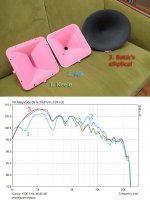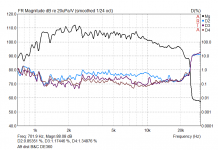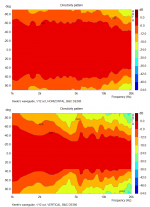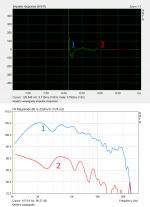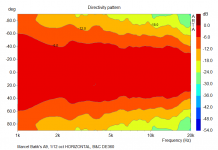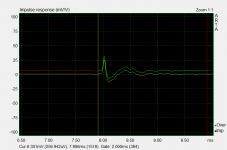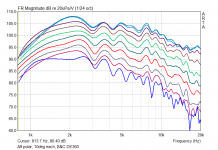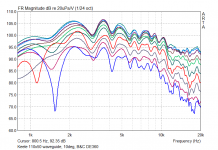SB17NAC35/SB17NBAC35 might do the trick.So please set the right entry angle for this driver. It should be easy enough to keep the current size. I sketched this one very quickly but now when I compare it to some other results it seems to be really good!
The challange now will be to find a good woofer. Because of the relatively small size it needs to be crossed quite high, like 1.5 - 1.8 kHz... There will be not many readily available drivers capable of that.
SB Acoustics SB17NBAC35-8 | HiFiCompass
It's up to you and your facilities. From the drawing you gave I assumed a box (?). The distance should not be less than about 1 m, preferably more, but that depends on a reflection-free space at your disposal. Measured gated, of course, 4 - 5 ms should be fine. Make it the same for both horns and the rest is not critical.
Last edited:
We'll see how the measurement turns out. That should determine a suitable diameter(s) of the woofer, among other things. Right now I would say that a 6" is too small, but who knows.SB17NAC35/SB17NBAC35 might do the trick.
- So far I must say I'm glad I kept the Behringers...
Last edited:
We'll see how the measurement turns out. That should determine a suitable diameter(s) of the woofer, among other things. Right now I would say that a 6" is too small, but who knows.
- So far I must say I'm glad I kept the Behringers...
They're SHOCKINGLY good.
I enjoy this hobby, but if you simply want a nice stereo those Behringers are incredible for the money.
Thank you. Was this unbaffled? I assume these polar maps are normalized to axis. Could you please show all the raw polars also as frequency response plots?
Only one remark - your IR window should start where the impulse starts, i.e. where the impulse response starts to deviate from zero. You seem to start the gate somewhere around the maximum of the impulse - that is generally wrong.
- Definitely it looks promising, for such a small horn. Now you can imagine how a bigger device would perform...
Only one remark - your IR window should start where the impulse starts, i.e. where the impulse response starts to deviate from zero. You seem to start the gate somewhere around the maximum of the impulse - that is generally wrong.
- Definitely it looks promising, for such a small horn. Now you can imagine how a bigger device would perform...
Last edited:
Unbaffled. Baffle was planned but couldn't find time. Normalized to 10deg.
Gate at maxiumum peak was only used for illustration - time difference between main pulse and second pulse. Why Keele's waveguide has second pulse?
One interesting phenomenon - I used RME babyface. In dual channel mode expreienced floating impulse response. Ivo suggest it could be driver nonlinearity and good to check other stimulus especially pink noise.
Gate at maxiumum peak was only used for illustration - time difference between main pulse and second pulse. Why Keele's waveguide has second pulse?
One interesting phenomenon - I used RME babyface. In dual channel mode expreienced floating impulse response. Ivo suggest it could be driver nonlinearity and good to check other stimulus especially pink noise.
Attachments
The second impulse arrives at ~0.8 ms, that is about twice the depth of the horn for a sound wave to travel, so that might be a reflected energy from mouth to driver and back again.
BTW, that's not that bad for unbaffled situation. Square seems to suffer less than an ellipse in this case.
At 7 - 8 kHz there wil be some imperfection in the driver, I've already seen this somewhere else.
BTW, that's not that bad for unbaffled situation. Square seems to suffer less than an ellipse in this case.
At 7 - 8 kHz there wil be some imperfection in the driver, I've already seen this somewhere else.
Last edited:
Unbaffled. Baffle was planned but couldn't find time. Normalized to 10deg.
Gate at maxiumum peak was only used for illustration - time difference between main pulse and second pulse. Why Keele's waveguide has second pulse?
One interesting phenomenon - I used RME babyface. In dual channel mode expreienced floating impulse response. Ivo suggest it could be driver nonlinearity and good to check other stimulus especially pink noise.
I got this floating impulse response problem in ARTA dual channel measurements with Babyface as well, so it is propably Babyface problem. It is a DC offset or other low frequency noise that ruins the dual channel measurement, some discussion on this subject in the ARTA thread. I'll try external mic pre next time.
Three waveguides shootout.
Thanks for printing them and posting the results. I recently tested a similar slot loaded horn and it's behaviour is like your posted results.
Thanks for printing them and posting the results. I recently tested a similar slot loaded horn and it's behaviour is like your posted results.
Same waveguide in commercial speaker:
ULT12 | PreSonus
BTW: We could do comparison with similar coverage. At 50deg no slot needed.
^ Here's the results Modular active 3 way - work in progress
Horn is 16cm across the flange edges and 10.5cm deep.
Horn is 16cm across the flange edges and 10.5cm deep.
Could you please show all the raw polars also as frequency response plots?
Here you are. I requested elliptical design from Dr. Keele for direct comparison. Do you remember that black elliptical data?
Attachments
- Home
- Loudspeakers
- Multi-Way
- Acoustic Horn Design – The Easy Way (Ath4)
